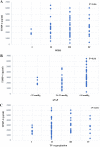The role of matrix metalloproteinases in patients with pulmonary hypertension: data from a prospective study
- PMID: 34930125
- PMCID: PMC8686623
- DOI: 10.1186/s12872-021-02424-5
The role of matrix metalloproteinases in patients with pulmonary hypertension: data from a prospective study
Abstract
Background: Despite several therapies, pulmonary hypertension (PH) is still a severe disease which can lead to right heart failure. Matrix metalloproteinases (MMPs) and tissue inhibitors of metalloproteinases (TIMPs) are involved in cardiac and vascular remodeling in PH. Therefore, these biomarkers play an important role in PH patients. This study investigated whether TIMP-4, MMP-2, and N-terminal Pro-B-Type Natriuretic Peptide (NT-proBNP) plasma levels are useful in assessing the severity of PH and other clinical or echocardiographic parameters.
Methods: The concentrations of MMP-2, TIMP-4, and NT-proBNP in 68 PH patients were compared with those of 12 controls without PH. All patients underwent a physical examination, echocardiography, and were checked for the presence of cardiovascular risk factors; also, plasma concentrations of MMP-2, TIMP-4, NT-proBNP, total cholesterol, and triglycerides were determined.
Results: In PH patients, significantly elevated plasma levels of TIMP-4 (PH: 2877.99 ± 1363.78 pg/ml, control: 2028.38 ± 762.67 pg/ml, p = 0.0068) and NT-proBNP ( PH: 2405.00 pg/ml-5423.47 ± 6703.38 pg/ml, control: 411.0000 pg/ml-421.75 ± 315.37 pg/ml, p = 0.01) were detected. We also observed that MMP-2 and NT-proBNP were significantly increased in patients with higher WHO functional class (p = 0.001 for MMP-2, p = 0.008 for NT-proBNP), higher pressure in the pulmonary artery (p = 0.002 for MMP-2, p = 0.001 for NT-proBNP), and more severe tricuspid regurgitation (p = 0.001 for MMP-2, p = 0.009 for NT-proBNP). TIMP-4 was elevated in patients with more severe pressure in the pulmonary artery (p = 0.006).
Conclusions: The plasma levels of TIMP-4 and NT-proBNP are higher in PH patients. MMP-2 and NT-proBNP correlates with different PH parameters severity (WHO functional class, sPAP severity, TV regurgitation severity). Therefore, plasmatic levels of MMP-2 and NT-proBNP at this kind of patients reflect disease severity and may have a prognostic role. MMP-2 can help assess the beneficial effects of PH pharmacotherapy on tissue remodeling. These remodeling biomarkers may not have a diagnostic value but they have the potential to predict survival. Nevertheless, a greater understanding of the involvement of MMPs in PH is mandatory to further explore the prognostic role and the possibilities of therapeutic MMP inhibition in PH.
Keywords: Biomarkers; Matrix metalloproteinase 2; N-terminal pro-B-Type Natriuretic peptide; Pulmonary hypertension; Right heart failure; Tissue inhibitor of matrix metalloproteinase 4.
© 2021. The Author(s).
Conflict of interest statement
The authors declare that they have no competing interests.
Figures





References
-
- Konstam MA, Kiernan MS, Bernstein D, Bozkurt B, Jacob M, Kapur NK, Kociol RD, Lewis EF, Mehra MR, Pagani FD, Raval AN, Ward C. Evaluation and management of right-sided heart failure: a scientific statement from the american heart association. Circulation. 2018;137:e578–e622. doi: 10.1161/CIR.0000000000000560. - DOI - PubMed
-
- Galiè N, Humbert M, Vachiery JL, Gibbs S, Lang I, Torbicki A, Simonneau G, Peacock A, Vonk Noordegraaf A, Beghetti M, Ghofrani A, Gomez Sanchez MA, Hansmann G, Klepetko W, Lancellotti P, Matucci M, McDonagh T, Pierard LA, Trindade PT, Zompatori M, Hoeper M; ESC Scientific Document Group. 2015 ESC/ERS Guidelines for the diagnosis and treatment of pulmonary hypertension: The Joint Task Force for the Diagnosis and Treatment of Pulmonary Hypertension of the European Society of Cardiology (ESC) and the European Respiratory Society (ERS): Endorsed by: Association for European Paediatric and Congenital Cardiology (AEPC), International Society for Heart and Lung Transplantation (ISHLT). Eur Heart J. 2016;37(1):67–119. 10.1093/eurheartj/ehv317. - PubMed
-
- Simonneau G, Gatzoulis MA, Adatia I, Celermajer D, Denton C, Ghofrani A, Gomez Sanchez MA, Krishna Kumar R, Landzberg M, Machado RF, Olschewski H, Robbins IM, Souza R. Updated clinical classification of pulmonary hypertension. J Am Coll Cardiol. 2013;62:D34–41. doi: 10.1016/j.jacc.2013.10.029. - DOI - PubMed
Publication types
MeSH terms
Substances
LinkOut - more resources
Full Text Sources
Medical
Research Materials
Miscellaneous

